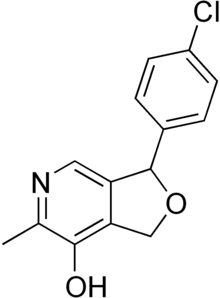 | |
| Clinical data | |
|---|---|
| AHFS/Drugs.com | International Drug Names |
| Routes of administration | Oral |
| ATC code | |
| Pharmacokinetic data | |
| Protein binding | 99.6% for (-)cicletanine isomer; 87.5% for (+)cicletanine isomer |
| Elimination half-life | 5.7 h. Also: Tmax = 0.750 hours. Plasma AUCinf = 29.0 μg·hr/mL. Cmax = 6.18 μg/mL. All figures are for a single oral dose of 150 mg. |
| Identifiers | |
| |
| CAS Number | |
| PubChem CID | |
| ChemSpider | |
| UNII | |
| KEGG | |
| ChEMBL | |
| CompTox Dashboard (EPA) | |
| ECHA InfoCard | 100.158.583 |
| Chemical and physical data | |
| Formula | C14H12ClNO2 |
| Molar mass | 261.71 g·mol−1 |
| 3D model (JSmol) | |
| |
| |
| (verify) | |
Cicletanine is a furopyridine compound approved in France for the treatment of hypertension.[1] The drug is most commonly known as a diuretic drug, but has a broader range of cardiovascular and metabolic activity characterized extensively in the literature (see "Mechanism" below).
Cicletanine was originated and in 1986 launched in France by Paris-based Ipsen, who in 2005 licensed marketing rights in France to Milan-based Recordati for several years (at least until 2010). Ipsen and Recordati both marketed cicletanine under the trade name Tenstaten. The drug is no longer manufactured nor sold by IPSEN; it is currently marketed in France by three generics manufacturers: Viatris, Biogaran, and Teva Pharmaceuticals.
Cicletanine has been shown to be differentially effective in salt-sensitive hypertension.[2]
- ^ Sassard J (1992). Genetic Hypertension. John Libbey Eurotext. ISBN 978-0-86196-313-3.
- ^ Bagrov AY, Dmitrieva RI, Dorofeeva NA, Fedorova OV, Lopatin DA, Lakatta EG, Droy-Lefaix MT (February 2000). "Cicletanine reverses vasoconstriction induced by the endogenous sodium pump ligand, marinobufagenin, via a protein kinase C dependent mechanism". Journal of Hypertension. 18 (2): 209–215. doi:10.1097/00004872-200018020-00012. PMID 10694190. S2CID 35374482.